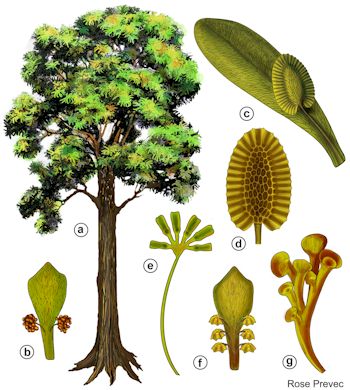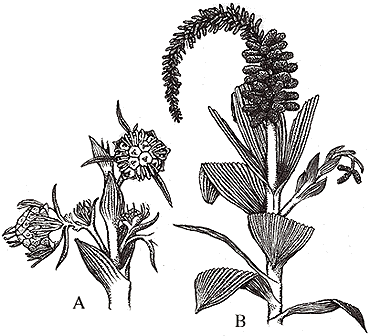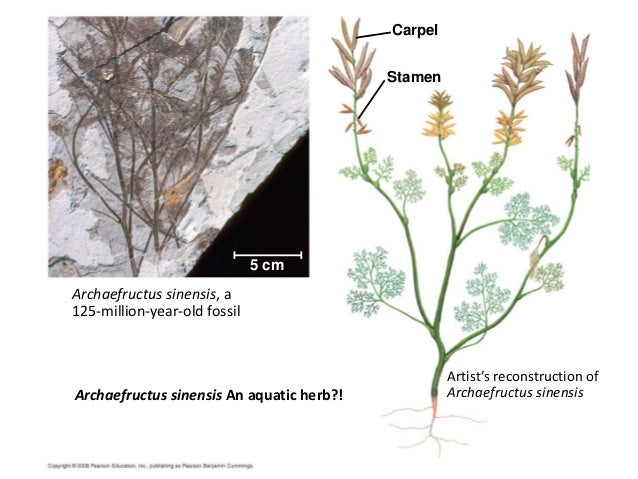Paleobotany II: Flowering plants
Seed review:
- The ovule: The derived sporangium of seed plants in which megaspores are produced and retained.
- The haploid female gametophyte develops inside the ovule, producing ova.
- Fertilization by sperm produces a zygote that develops into an embryo.
- After fertilization, the ovule develops into a seed, and haploid cells of the ovule develop into "endosperm", nutritional tissue for the embryo.
When we get past the paraphyletic grade group of "seed ferns," Tracheophyta contains two major groups:
- Anthophyta: Flowering plants and their kin
- Acrgymnoseprmae: The traditional - "Gymnospermae" (naked seed) - non-flowering seed plants.
Acrogymnospermae: (Devonian - Quaternary) Deemed paraphyletic in earlier literature, the traditional "gymnosperms" have emerged from recent molecular analyses as a monophyletic group. An interesting fact for its own sake, but also because it implies that the evolutionary "roots" of flowering plants go back to the mid-Paleozoic.
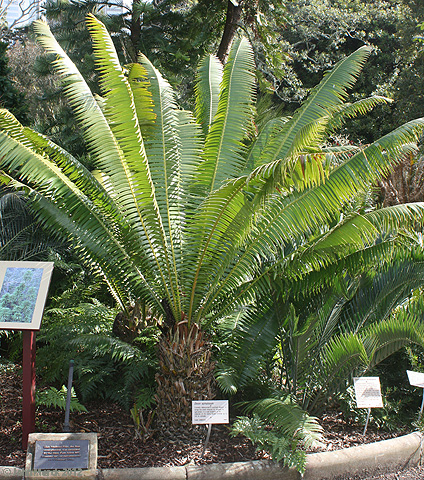
Dioon spinulosum
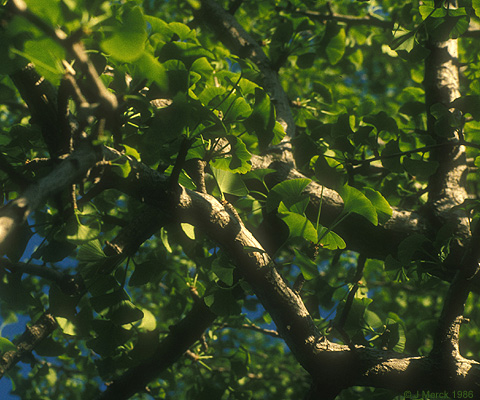
Ginkgo biloba
Represented by a single species, Ginkgo biloba, but more speciose during the Mesozoic. Ginkgoes began to decline during the Cretaceous and were significantly reduced by the end of the Paleocene. (Possibly because the animals on which they depended to disperse their seeds had also declined.)
With the exception of a small region of southwestern China, ginkgoes are extinct in the wild. Thankfully, they are common under cultivation.
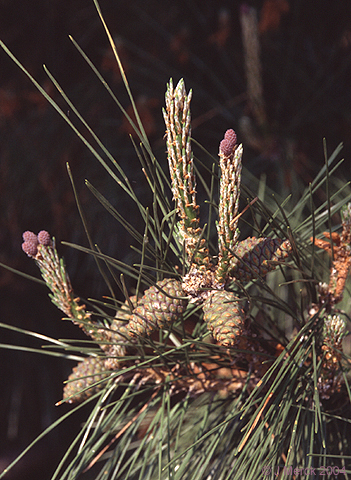
Pinus nigra
Crown-group Pinophyta includes of the Pinales (Carboniferous - Quaternary) Important canopy trees of late Paleozoic and Mesozoic forests. Representatives include:
A fourth group requires notice:
Gnetophyta: (Ephedra, Welwitschia, and Gnetum.) Triassic-Quaternary. Weird arid adapted plants with flower-like strobili that enclose the ovule in an integument that is open at the end.
Until recently, we would have presented Gnetophyta as close relatives of flowering plants, however strong recent molecular evidence indicates that they are actually nested within Pinales - counterintuitive but strongly supported.
Anthophyta: Carboniferous - Quaternary) The total group of flowering plants and their kin. The familiar term Angiopspermae refers to the crown-group.
Before addressing the evolution of the innovations, of flowering plants, bet to have a sense of where we are headed. Simply to say that flowering plants are distinguished by flowers would be sort of dumb. In fact, flowers represent three major innovations:
- Unlike other seed plants, in which pollen and ovule producing structures are completely separate, flowers combine them in a single complex structure.
- The pollen-organ is the stamen
- The ovulate organ is the pistil, a composite containing:
- One or more carpels - the specialized leaves from which the ovules are suspended (homologous with the scales of a conifer ovulate cone.)
- The stigma, to which pollen grains attach
- The style, with guides the pollen tube to the ovule.
- Perianth, the circle of specialized leaves (petals and sepals) inclosing the pistil and stamens.
- Unlike in other seed plants, the ovule is completely concealed by hte carpel. When the ovule is fertilized, the carpel of many species swells to form a fruit, whose primary purpose seems to be to intice animals into consuming the seed. This allows the seed to hitch a ride in the animal's gut and insures that it will be deposited with a blob of fertilizer. Indeed, some seeds can't germinate without first passing through someone's gut.
- The specialized leaves (petals, sepals) of the perianth along with secretions of nectar function to attract pollinators, usually insects. In the latter two adaptations, the plant "pays" animals to transport pollen directly to other flowers, and to disperse seeds, resulting in an increase in reproductive efficiency.
-
But that is tame. The angiosperm seed is derived in that the endosperm - the tissue that nourishes the embryo - forms from the fusion of sperm with a special diploid cell of the ovule. After fertilization, this triploid cell develops into the endosperm. (Think of it as if everyone shared the womb with a fraternal twin whom they were supposed to eat.) In non-anthophytes, this nutrient tissue is haploid.
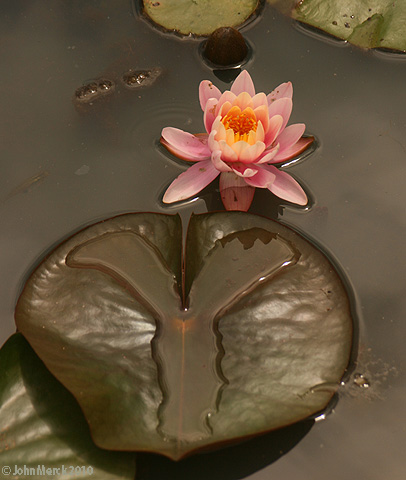
Nymphaea sp. - Angiosperms tend to have broad leaves with branching venation, in which the veins show multiple orders of branching, cross veins, and
Anthophyte Evolution:
-
Gigantopteridales: (Permian) Major portion of Late Paleozoic and Triassic Gondwanan flora. These bore distinct ovulate and stamenate reproductive structures on separate specialized leaves - the ancestral lignophyte pattern. Were derived in their development of broad non-pinnate leaves.
-
Glossopteridales: (Permian - Triassic) Major portion of Late Paleozoic and Triassic Gondwanan flora. These, again, bore distinct ovulatte and stamenate reproductive structures on separate specialized leaves. Note, the Permian Glossopteris was a particularly significant member of the Gondwanan flora.
-
Bennettitales: (Triassic - Cretaceous) (Sometimes called "Cycadeoids.") Superficially resembling cycads with short trunks covered by leaf scars and pinnate leaves. Their reproductive structures are different. First, like most flowering plants, they are hermaphrodites. Second, some display flower-like cones in which the ovule is contained in a central recepticle surrounded by specialized leaves (bracts) that might be homologous to petals. In some, microspore (pollen) producing structures are arrayed radially around it, like stamens - a truly flower-like arrangement. Alas, not all bennettitaleans show this, so this bisexual reproductive structure seems to be convergent with angiosperms.
-
Sanmiguelia lewisii: (Triassic) Described by Cornet 1986 as having:
- Separate stamenate and ovulate reproductive structures in which the latter were very similar to those of angiosperms.
- Leaf venation patterns similar to those of angiosperms.
-
Archaefructus eoflora: (Early Cretaceous): An aquatic plant. In contrast to Sanmiguelia which seems to have male and female structures on distinct branches, Archaefructus eoflora is described by Ji et al., 2004 as having a single enflorescences (branches covered with small reproductive structures) in which:
- the distal structures were stamenate
- the proximal ones were ovulate
- But where they met were a few rows of composite bisexual structures.
Angiospermae:
(Cretaceous - Quaternary) The crown group of living anthophytes.Angiosperms appear unambiguously in the fossil record in the Early Cretaceous. Today, they are the dominant plant type, with over 200,000 known species (compared to 550 species of gymnosperms).
Both the ecologies of their fossil relatives Sanmiguelia and Archaefructus, and of their basal living members suggest that they inhabited wetlands.
Angiosperm partners:
We've noted the big angiosperm innovation - the use of animal commensalists to pollinate flowers and disperse seeds. Who were these? Some speculation:- Herbivorous mammals and squamates of the Early Cretaceous were mostly small, but could have eaten berry-sized fruit.
- Herbivorous crocodyliforms were rare, but did exist
- But herbivorous dinosaurs were quite common, and could easily eat and transport a plenty of fruit! Since most early angiosperms were built low to the ground, it would be small and/or low-browsing forms that would have been the main agents of transportation for fruit.
- No Early Cretaceous archosaur shows nectar-eating adaptations.
- Mammals were small, and may have been pollinators, but bats - the great modern mammalian pollinators - did not exist.
- Insects (including beetles, dipterans (flies), lepidopterans (butterflies and moths), and hymenopterans (wasps, bees, and ants)) were present, and were almost certainly the main pollinators in the Mesozoic just as they are today.
- In fact, the major groups of holometabolous insects that are the major pollinators today tend to diversify greatly around the time of angiosperm origins.
Fruit eaters:
Arthropods might like to eat the fleshy parts of fruit, but they destroy them in the process. Plants develop fruit to select for something that can eat the whole fruit and spread the seeds. During the Mesozoic, that could only be a vertebrate.
Flower sniffers:
Was anyone else on the scene to fill this role? In fact, mecopteran insects (today represented by scorpionflies) appear to have served that role. Rather than being predators, like the living members, fossil Cretaceous scorpionflies did not have biting jaws, but instead butterfly-like probing snouts.
Angiosperm diversity:
- Traditionally, flowering plants have been divided into Dicotyledonae and Monocotyledonae (commonly dicots and monocots). Although there are many morphological distinctions (see today's lab) the names derive from a major difference in their embryos:
- Dicots embryos have two cotyledons - embryonic first leaves.
- Monocots have one cotyledon.
Great. Now forget it! "Dicots" are paraphyletic.
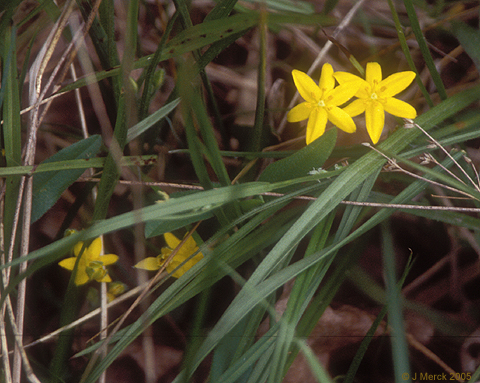
Yellow stargrass - Hypoxis hirsuta
- Phylogentic systematists have confirmed that Monocotyledonae is monophyletic, however dicots are not.
- Most "dicots" do fall within a monophyletic "Eudicotyledonae", however some, including:
- water-lillies
- star anise
- Amborella
- magnolias
- Monocotyledonae appear in the Cretaceous and include lillies (right), orchids, grasses, palms, etc. Note that grasses appeared in the Eocene and proliferated during the Oligocene, transforming much of the world by converting arid and semi-arid regions to grasslands.
C3 and C4 plants: Depending on the plant, two distinct photosynthetic pathways are employed by plants, termed C3 and C4. Most plants use C3. The C4 pathway conserves water and it present in arid adapted plants and grasses.
Basal Angiosperms:
- Amborella trichopoda most primitive. Although weird for being dioecious (plesiomorphy?), otherwise suggests the structure of the ancestral flower:
- very small
- petals and sepals undifferentiated
- ovum development resembles that of nonflowering plants
- Nymphaeaceae Water lilies.
- Austrobaileyales including star anise.
- Magnoliidae: Including magnolias and laurels.
- Chloranthales
- Sister taxon to Eudicotyledonae: Ceratophyllaceae - Fresh water aquatic plants.
But we note that water-lilies have endosperm that is merely diploid - a plesiomorphy or autapomorphy?








